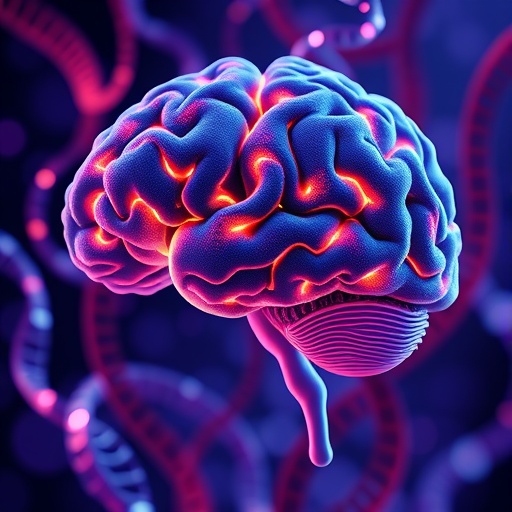Alzheimer’s Disease (AD) continues to charge forward as the most pervasive cause of dementia worldwide, afflicting nearly 40 million individuals. This neurodegenerative disorder manifests predominantly through progressive memory decline and loss of autonomy, and despite decades of research focus, no therapeutic agents currently exist that can arrest or reverse its relentless course. An emerging study now sheds light on an intriguing molecular pathway that may revolutionize the search for effective treatment strategies.
Neuronal dysfunction at the heart of AD prominently involves the microtubule-associated protein tau. Under physiological conditions, tau stabilizes neuronal cytoskeletal architecture, functioning analogously to railroad tracks facilitating intracellular transport essential for neuronal viability. However, pathological modifications induce tau to adopt abnormal conformations, promoting aggregation and impairing axonal transport. This pathological cascade contributes to synaptic dysfunction and neurodegeneration, culminating in memory impairment typical of AD.
A groundbreaking international collaboration, spearheaded by Associate Professor Evandro Fei Fang from the University of Oslo and Akershus University Hospital, has uncovered a novel mechanism by which augmenting the cellular metabolite nicotinamide adenine dinucleotide (NAD⁺) may confer robust neuroprotection in AD. Their pivotal work, detailed in Science Advances, elucidates how NAD⁺ modulates a previously unidentified RNA splicing pathway mediated by the protein EVA1C, thereby reversing AD-associated neurological deficits.
NAD⁺, a central coenzyme in redox reactions, governs critical aspects of cellular metabolism, particularly in energy-demanding neurons. Its natural decline with aging and in neurodegenerative states contributes to diminished neuronal resilience. While supplementation with NAD⁺ precursors such as nicotinamide riboside and nicotinamide mononucleotide demonstrates therapeutic promise in preclinical AD models, the molecular underpinnings remained enigmatic. This study for the first time pinpoints that NAD⁺ acts through regulation of alternative RNA splicing events, orchestrated by EVA1C, a protein that influences splicing precision and fidelity.
RNA splicing is a sophisticated post-transcriptional modification allowing a single gene to yield multiple protein isoforms with divergent functions. Perturbations in splicing mechanisms have recently been implicated as critical stakeholders in AD pathogenesis, with splicing errors exacerbating neuronal vulnerability. The research team demonstrated that elevated NAD⁺ levels restore proper RNA splicing patterns, mediated through ETA1C’s modulation, correcting aberrant isoform expression across hundreds of genes essential for brain homeostasis and neuronal functionality.
To validate this mechanism, the investigators employed a cross-phyla approach, analyzing invertebrate models, murine systems, and also human brain tissue samples. Initially, age-dependent disruptions in RNA splicing profiles were identified in nematode models, which manifest a tauopathy phenotype akin to human AD. NAD⁺ supplementation rectified mis-splicing induced by pathological tau. In genetically engineered mice harboring tau mutations, NAD⁺ treatment partly reestablished RNA splicing integrity, ameliorated cognitive deficits, and restored memory performance.
Importantly, targeted RNA interference to knock down EVA1C expression abolished the beneficial effects of NAD⁺, underscoring EVA1C as an indispensable mediator in this protective signaling axis. Complementing animal model experiments, quantitative analyses of human brain samples from individuals in early stages of AD pathology revealed significant reductions in EVA1C expression, reinforcing the clinical relevance of this pathway.
Harnessing the power of artificial intelligence, the team employed an advanced computational platform integrating structural biology, protein sequence alignment, and evolutionary conservation data to decode interactions between EVA1C and other cellular machinery. This AI-driven model predicted that NAD⁺ facilitated generation of an EVA1C isoform with enhanced binding affinity to proteins pivotal in proteostasis, including those involved in protein folding and clearance.
This integrative network links metabolic homeostasis, RNA splicing fidelity, and protein quality control—three processes recognized as critically impaired in Alzheimer’s disease. NAD⁺, by promoting a functional EVA1C isoform, maintains proteomic integrity alongside genetic regulatory mechanisms, suggesting a multitiered approach to mitigate neurodegeneration.
The implications of these findings are profound, heralding potential for innovative therapeutic interventions centered on NAD⁺ augmentation tailored to sustain EVA1C-mediated RNA splicing. As neuronal identity and cognitive function depend on precise gene expression programs, preserving NAD⁺ pools could delay disease onset or progression. This opens avenues for combination therapies to potentiate RNA splicing correction alongside metabolic support.
This international effort exemplifies the value of collaborative science across continents—integrating expertise from Norway, China, Portugal, the UK, Japan, Greece, and Spain to confront the complexities of neurodegeneration. The study’s co-first authors, including Alice Ruixue Ai, Lipeng Mao, Xurui Jin, and C. Campos-Marques, collectively contributed critical experimental validation and computational analyses advancing current understanding.
In sum, the discovery that NAD⁺ restores neuronal function by regulating differential alternative RNA splicing through EVA1C represents a paradigm shift in Alzheimer’s research. It highlights the intricate interplay between metabolism, gene regulation, and protein homeostasis, offering a beacon of hope for developing disease-modifying therapeutics in this devastating disorder.
Subject of Research: Alzheimer’s Disease; Neurodegeneration; NAD⁺ metabolism; RNA Splicing; Protein EVA1C
Article Title: NAD+ reverses Alzheimer’s neurological deficits via regulating differential alternative RNA splicing of EVA1C
News Publication Date: 7-Nov-2025
Web References: http://dx.doi.org/10.1126/sciadv.ady9811
Keywords: Alzheimer’s Disease, NAD⁺, RNA splicing, EVA1C, tau protein, neurodegeneration, alternative splicing, nicotinamide riboside, nicotinamide mononucleotide, proteostasis, AI modeling, neuroprotection
Tags: Alzheimer’s Disease and RNA repair mechanismscellular metabolites in brain healthEvandro Fei Fang’s research contributionsinternational collaboration in Alzheimer’s researchmemory restoration in dementia modelsNAD⁺ and Alzheimer’s Diseaseneurodegenerative disorders and treatment strategiesneuroprotection mechanisms in Alzheimer’snovel therapeutic pathways for Alzheimer’sRNA splicing in neuroprotectionsynaptic dysfunction in Alzheimer’stau protein aggregation and memory loss





